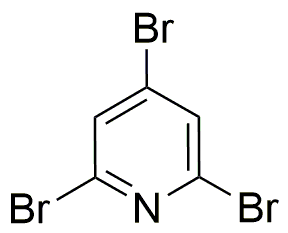2,4,6-Tribromopyridine is widely utilized in research focused on:
- Pesticide Development: This compound serves as an important intermediate in the synthesis of various agrochemicals, enhancing crop protection against pests.
- Pharmaceutical Research: It is used in the development of new pharmaceuticals, particularly in creating compounds that target specific biological pathways.
- Material Science: The chemical is incorporated into polymer formulations to improve flame retardancy, making materials safer for various applications.
- Analytical Chemistry: It acts as a reagent in analytical methods, aiding in the detection and quantification of other substances in complex mixtures.
- Organic Synthesis: This compound is a valuable building block in organic synthesis, allowing for the creation of diverse chemical structures with potential applications in multiple industries.
General Information
Properties
Safety and Regulations
Applications
2,4,6-Tribromopyridine is widely utilized in research focused on:
- Pesticide Development: This compound serves as an important intermediate in the synthesis of various agrochemicals, enhancing crop protection against pests.
- Pharmaceutical Research: It is used in the development of new pharmaceuticals, particularly in creating compounds that target specific biological pathways.
- Material Science: The chemical is incorporated into polymer formulations to improve flame retardancy, making materials safer for various applications.
- Analytical Chemistry: It acts as a reagent in analytical methods, aiding in the detection and quantification of other substances in complex mixtures.
- Organic Synthesis: This compound is a valuable building block in organic synthesis, allowing for the creation of diverse chemical structures with potential applications in multiple industries.
Documents
Safety Data Sheets (SDS)
The SDS provides comprehensive safety information on handling, storage, and disposal of the product.
Product Specification (PS)
The PS provides a comprehensive breakdown of the product’s properties, including chemical composition, physical state, purity, and storage requirements. It also details acceptable quality ranges and the product's intended applications.
Certificates of Analysis (COA)
Search for Certificates of Analysis (COA) by entering the products Lot Number. Lot and Batch Numbers can be found on a product’s label following the words ‘Lot’ or ‘Batch’.
*Catalog Number
*Lot Number
Certificates Of Origin (COO)
This COO confirms the country where the product was manufactured, and also details the materials and components used in it and whether it is derived from natural, synthetic, or other specific sources. This certificate may be required for customs, trade, and regulatory compliance.
*Catalog Number
*Lot Number
Safety Data Sheets (SDS)
The SDS provides comprehensive safety information on handling, storage, and disposal of the product.
DownloadProduct Specification (PS)
The PS provides a comprehensive breakdown of the product’s properties, including chemical composition, physical state, purity, and storage requirements. It also details acceptable quality ranges and the product's intended applications.
DownloadCertificates of Analysis (COA)
Search for Certificates of Analysis (COA) by entering the products Lot Number. Lot and Batch Numbers can be found on a product’s label following the words ‘Lot’ or ‘Batch’.
*Catalog Number
*Lot Number
Certificates Of Origin (COO)
This COO confirms the country where the product was manufactured, and also details the materials and components used in it and whether it is derived from natural, synthetic, or other specific sources. This certificate may be required for customs, trade, and regulatory compliance.


